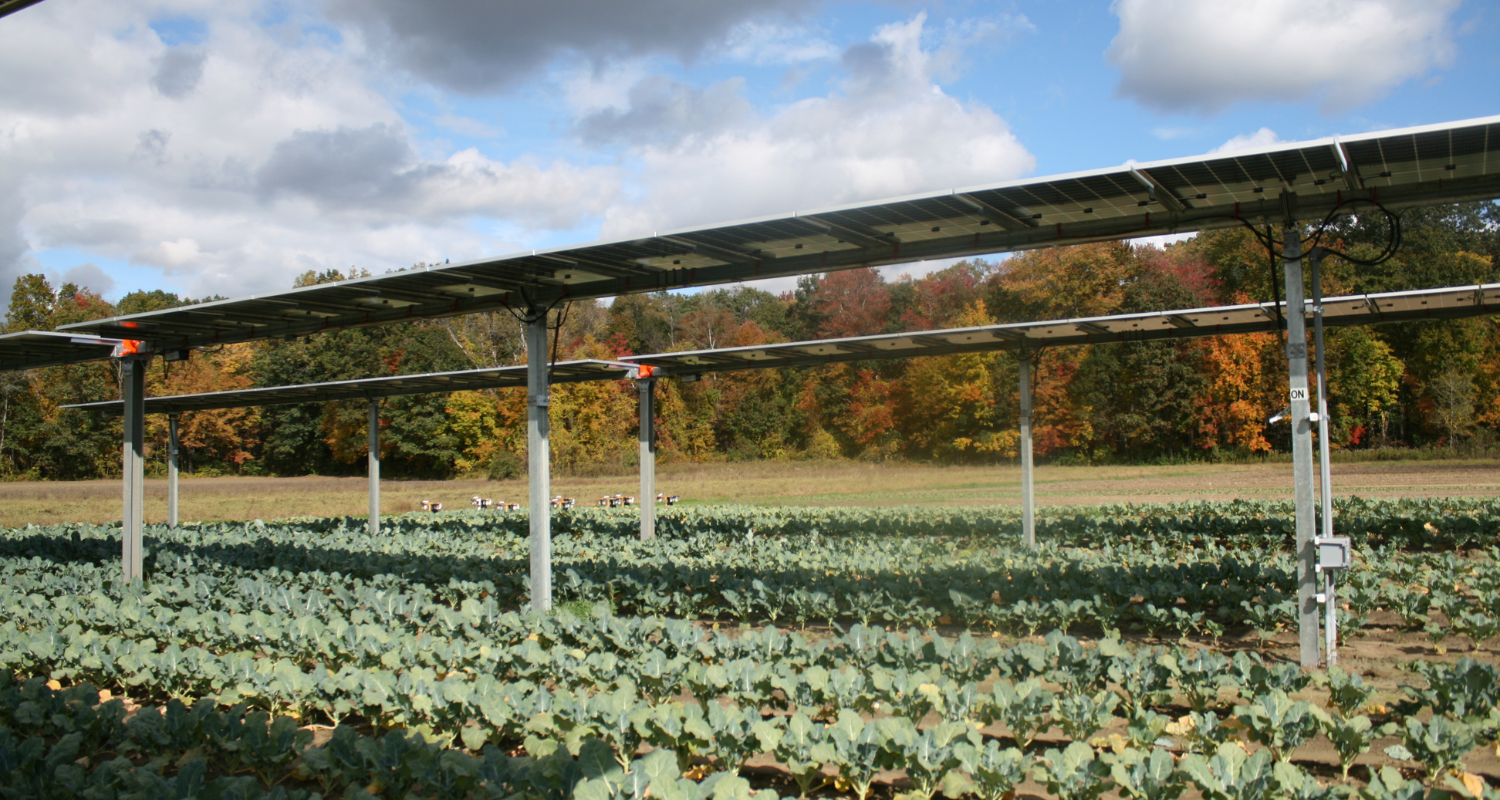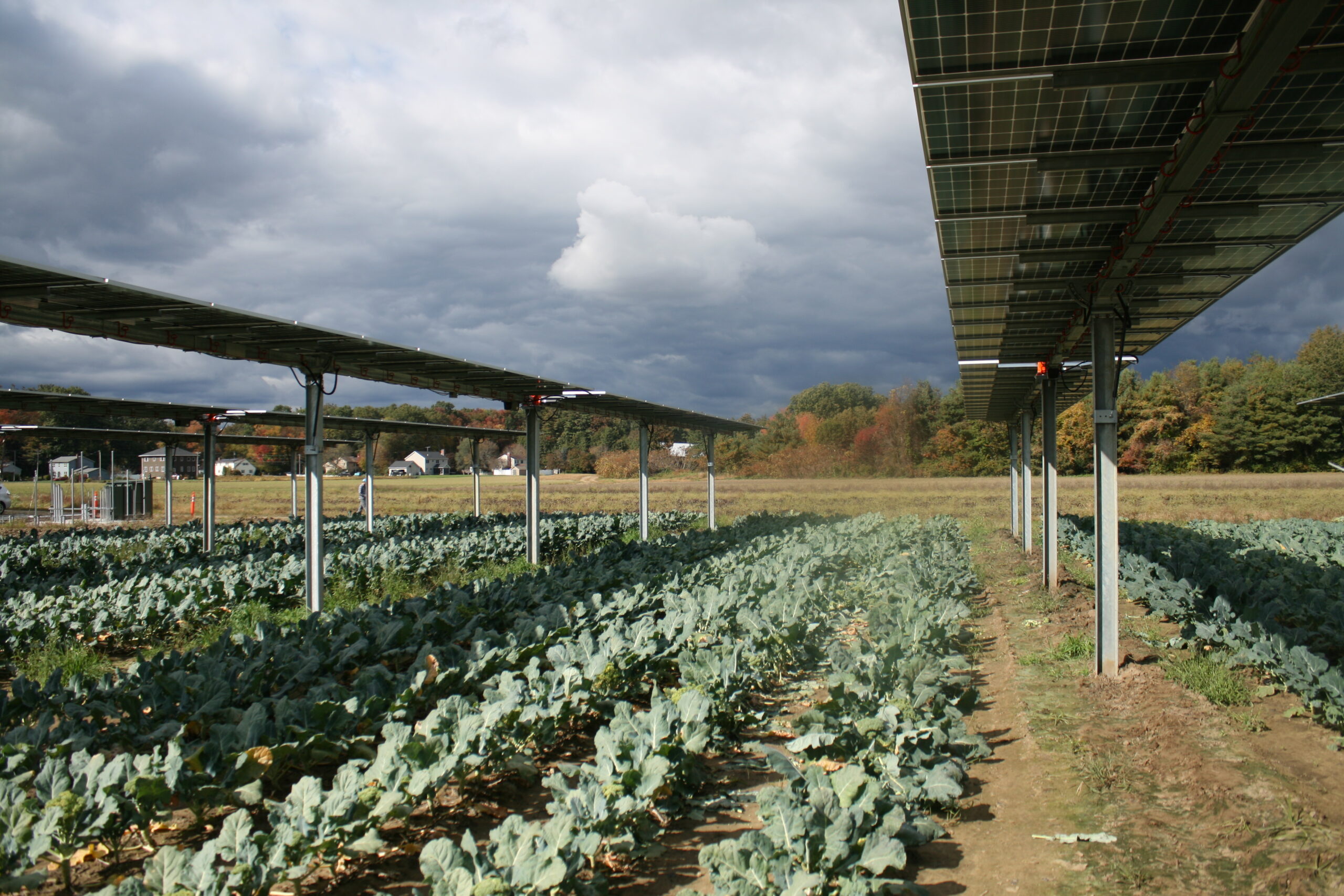In Massachusetts, Proof Grows of Benefits for Combining Solar and Agriculture

Nestled into the picturesque hills of Massachusetts’ Pioneer Valley is a 100-year-old farm redefining what it means to be sustainable in a region long concerned with its environmental footprint.
The first sight many visitors will notice when pulling into Czajkowski Farm is one that might seem unfamiliar—a field of broccoli being grown under the watchful eye of solar panels standing overhead. This technique of growing crops and generating energy on the same parcel is called agrivoltaics. While these projects may currently stick out in Massachusetts combining solar and agriculture, they are growing in popularity across the nation because of the opportunities they provide to keep land in agriculture and build resilience to climate change.
“Every farm in this valley has a few acres that are marginal, whether it’s rocky or stony or steep, or windswept. When we take the panels down, the field will be better than when we went into it. I think there’s a place on every farm for this.”
-Joe Czajkowski, Czajkowski Farm

Like many landowners, Joe Czajkowski has spent the past few years thinking strategically about how to ensure his land can remain viable in the face of increasingly severe weather, market disruptions, and rising prices of key agricultural inputs. As the owner of Czajkowski Farm and a third-generation farmer, investing in the future of land in the Pioneer Valley is important to Czajkowski.
“Every farm in this valley has a few acres that are marginal, whether it’s rocky or stony or steep, or windswept. There’s no reason that these 20 or 22 years of doing solar can’t be used to improve the soil and organic matter, and the quality of the land. When we take the panels down, the field will be better than when we went into it. I think there’s a place on every farm for this.”
While Joe became interested in investing in solar as a way to decrease his $75,000 yearly electric bill, it was a connection from a neighbor that set the agrivoltaic project at Czajkowski Farm into motion. It just so happens that Czajkowski’s neighbor is Dr. Stephen Herbert, Professor of Agronomy at UMass Amherst Stockbridge School of Agriculture.
In 2010, Hyperion Systems completed a dual-use test site at the University of Massachusetts, Amherst Animal and Crop Research and Education Center in South Deerfield, just a few miles up the road from Joe. Since agrivoltaic projects are fairly new in the industry, the ability of a farmer to see one in action can be crucial in demonstrating the potential of this new technology. According to Joe, the opportunity to build an array like the one at UMass on a small, wind-swept portion of his land just seemed like the “right thing to do.” Dr. Michael Lehan, a consultant to Hyperion, connected Joe with Jake Marley of Hyperion Systems, and the planning process began.
“My approach with Joe and other potential clients is to ask them to teach me about their farm and their operation. I want to work together to see how this might fit in and where it would be a good fit. I don’t think it really works with a hard-selling approach. It really does need to be collaborative and work for all parties.”
– Jake Marley, Hyperion Systems

“My approach with Joe and other potential clients is to ask them to teach me about their farm and their operation,” said Jake Marley of Hyperion Systems. “I want to work together to see how this might fit in and where it would be a good fit. I don’t think it really works with a hard-selling approach. It really does need to be collaborative and work for all parties.”
When I visited the site in early November, it was hard not to be struck by the innovation at play. Joe’s project was completed this past July, but the planning had been over two years in the making. Spanning roughly 2.2 acres, the project features 832 solar panels that are raised 10 feet off the ground and designed to track the sunlight throughout the day. Prior to construction, the parcel had grown onions almost exclusively, and the quality of the soil had degraded over the years.
Joe’s vision was clear: to make this piece of land more viable. His farm’s average annual electric bill is around $75,000. As a subscriber to the agrivoltaic project, Joe will receive a 17.5% monthly discount on his utility bills, resulting in savings of roughly $13,125 per year. “We put solar on another building where we pack carrots,” Joe adds, “and instead of having a bill, I had a $12,000 credit, which is kind of nice too.” Beyond energy cost savings, the array enabled the construction of a well, access to electricity at the remote farm field, and improvements to the access road, further enhancing the farm’s infrastructure.
“We put solar on another building where we pack carrots and instead of having a bill, I had a $12,000 credit.”
-Joe Czajkowski, Czajkowski Farm

For Joe, embracing solar on his land is more than a short-term investment, it’s an important part of his retirement plan. As he says, “Farmers don’t get pensions; this is my pension.” Joe’s forward-thinking approach secures a sustainable future for his beloved farm. The success of the agrivoltaic array has encouraged Joe to consider experimenting with different crops under the panels. UMass is currently purchasing the broccoli they are growing, and Joe’s enthusiasm extends to trialing shade tobacco, broiler chickens, blueberries, and other crops at the location.
For Jake, the completion of this array also serves as proof of concept, encouraging other farmers to explore similar opportunities. Joe’s advocacy goes beyond his farm; he has spoken to other farmers who have expressed their interest, amplifying the potential for widespread adoption in the region.
Joe Czajkowski’s pioneering project highlights several key takeaways. It’s a viable option for farmers planning for the future of their farm and demonstrating how low-impact land use can result in substantial electric savings. Joe’s credibility positions him as a catalyst for inspiring other farmers in the area to explore opportunities that fit with their farms. Hyperion has 10 MW AC of agrivoltaic projects in development; including the next project to be built Spring ‘24 in Mattapoisett which will feature cattle grazing under panels. Joe’s story demonstrates how a single farm can become an example of sustainability and innovation, influencing the agricultural landscape of the Pioneer Valley.
To learn more about Joe’s project and Hyperion Systems, visit https://hyperionsystemsllc.com. If you’re interested in learning more about combining solar and agriculture in Massachusetts and AFT’s Smart Solar work, visit https://farmland.org/solar.

